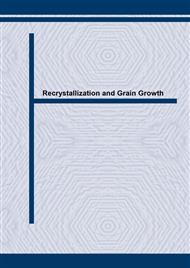p.1093
p.1099
p.1105
p.1111
p.1117
p.1123
p.1129
p.1137
p.1145
Monte Carlo Method for Simulating Grain Growth in 3D Influence of Lattice Site Arrangements
Abstract:
A three-dimensional Monte Carlo computer simulation technique has been applied to the problem of normal grain growth. A continuum system is modelled employing a discrete lattice. In this paper we investigate the connectivity of the points that represent the discretized microstructure. The lattice can have a strong influence on the result of the simulation. Only the BCC lattice with 14 neighbours gives similar results than the traditional simple cubic model with 26 neighbours. If we consider the computing time and the required computer memory, the BCC-14 model is a good alternative to the SC-26 model for simulating normal grain growth.
Info:
Periodical:
Pages:
1117-1122
Citation:
Online since:
October 2004
Authors:
Keywords:
Price:
Сopyright:
© 2004 Trans Tech Publications Ltd. All Rights Reserved
Share:
Citation:


